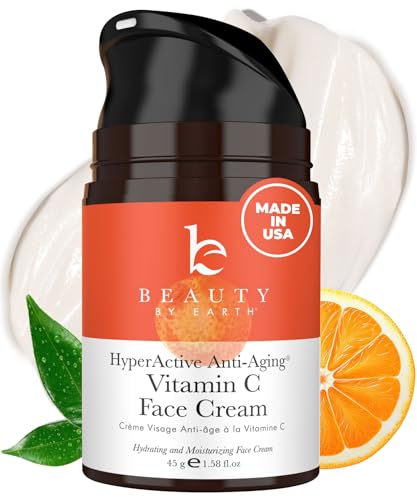
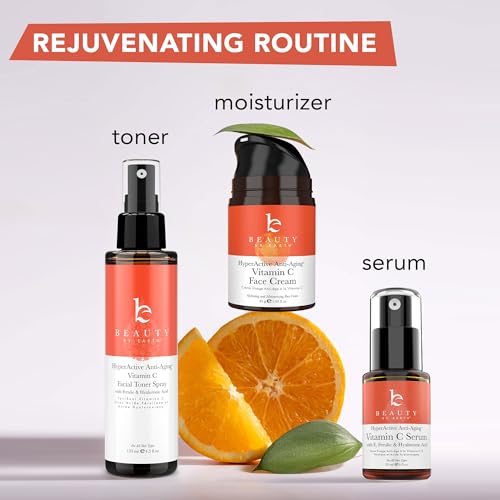
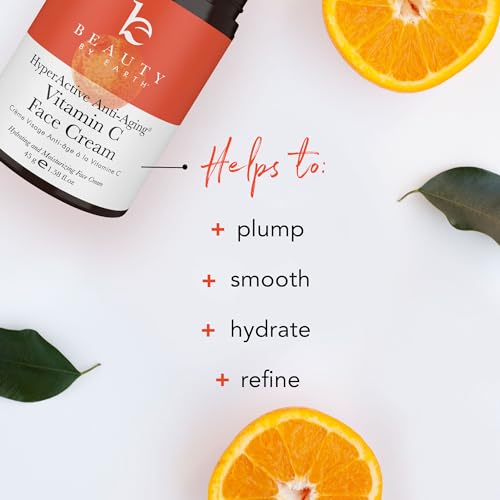
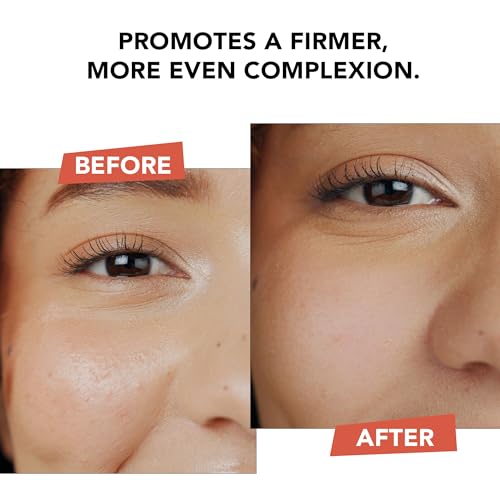
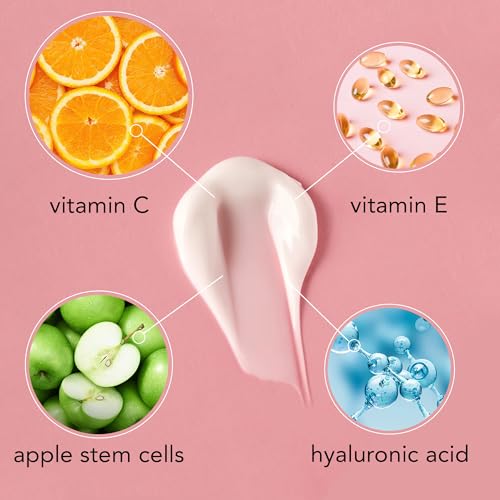
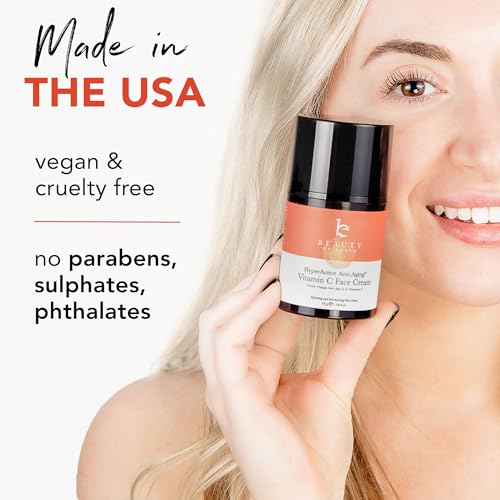
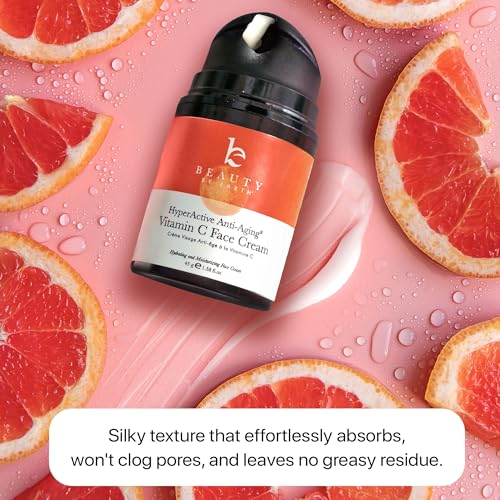
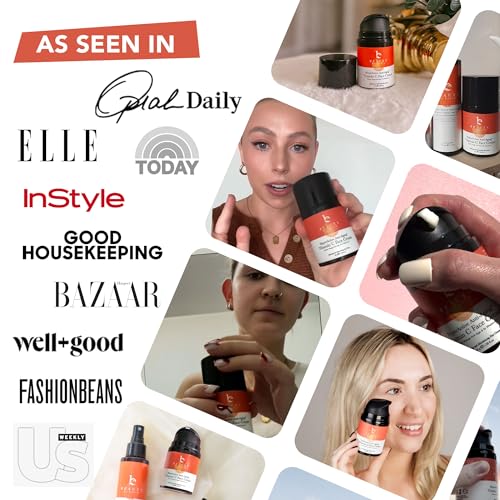
Beauty by Earth Vitamin C Face Moisturizer - Brightens, Reduces Discoloration, USA Made - 2oz


Thioctic Acid
Medium RiskThioctic acid, also known as alpha-lipoic acid, is a naturally occurring compound that functions primarily as an antioxidant. It is involved in energy metabolism and plays a role in the neutralization of free radicals in the body. Thioctic acid is commonly used in skincare products for its purported skin health benefits.
Sustai Insights
Thioctic acid provides functional benefits as an antioxidant, supporting skin health and energy metabolism. It is not associated with significant health risks, as concerns such as carcinogenicity, allergenic potential, and reproductive toxicity are low. However, regulatory use restrictions exist, contributing to a medium overall risk level. Environmental impacts appear limited, with no significant pollutant or bioaccumulation potential identified. Safe usage practices should be followed, and alternatives such as less restricted antioxidants may be considered.
Citrus Aurantium Dulcis (Orange) Peel Oil
Medium RiskCitrus aurantium dulcis (orange) peel oil is derived from the peel of oranges and is commonly used in cosmetic and personal care products for its fragrance and potential skin benefits. It is known for its aromatic properties and is often included in formulations aimed at enhancing scent profiles.
Sustai Insights
Citrus aurantium dulcis (orange) peel oil offers functional benefits such as providing a pleasant scent and potential antimicrobial properties. However, it poses a high allergy risk and may cause skin irritation in sensitive individuals. Environmental concerns include moderate persistence and potential to contribute to pollution. Regulatory warnings indicate restrictions on use in certain products. Overall, the risk level is assessed as medium, and users are advised to practice caution, particularly those with known allergies. Alternatives like sweet orange essential oil may provide similar benefits with potentially lower risks.
Citrus Paradisi (Grapefruit) Oil
Medium RiskCitrus paradisi (grapefruit) oil is an essential oil derived from the peel of grapefruit. It is commonly used in personal care products for its fragrance and potential antibacterial properties. It is also utilized in aromatherapy and cosmetic formulations for its refreshing scent.
Sustai Insights
Citrus paradisi oil offers functional benefits such as fragrance enhancement and potential antimicrobial properties. However, it presents a high allergenic potential, which may cause skin irritation or allergic reactions in sensitive individuals. Environmental concerns include its persistence and bioaccumulation. Regulatory advisories exist that restrict its use in certain products, leading to an overall moderate risk assessment. Safe usage practices should be followed to minimize health risks, and alternatives such as essential oils with lower allergenic profiles could be considered.
Ubiquinone
Medium RiskUbiquinone, also known as coenzyme Q10, is a naturally occurring antioxidant found in the body, primarily in the mitochondria. It plays a crucial role in energy production and is commonly used in skincare and dietary supplements for its potential health benefits and ability to support cellular function.
Sustai Insights
Ubiquinone provides functional benefits as an antioxidant, aiding in energy production and skin health. It is generally considered safe, with low risks for carcinogenicity, allergies, and immunotoxicity, although moderate concerns exist regarding developmental and reproductive toxicity and certain usage restrictions. Environmental impacts are minimal, with no significant bioaccumulation noted. Regulatory bodies do not impose severe restrictions, but users should adhere to recommended concentrations. Overall, this ingredient presents a medium risk level, and alternatives like alpha-lipoic acid may be considered for those seeking different antioxidant options.
Sorbitan Olivate
Low RiskSorbitan olivate is a surfactant derived from olive oil and sorbitol. It functions primarily as an emulsifier, allowing for the mixing of oil and water in cosmetic formulations. It is commonly found in creams and lotions, enhancing texture and stability.
Sustai Insights
Sorbitan olivate offers functional benefits as an emulsifier, improving product texture and stability while being derived from a sustainable source. Health risks are low, with no significant concerns regarding carcinogenicity, allergies, or reproductive toxicity. Environmentally, it is not known to bioaccumulate or contribute to pollution. Regulatory bodies have not identified restrictions, indicating a favorable risk level. For safe usage, it is recommended in standard cosmetic formulations, with few alternatives necessary given its low-risk profile.
Argania Spinosa (Argan) Kernel Oil
Low RiskArgania spinosa (argan) kernel oil is a fixed oil extracted from the kernels of the argan tree, native to Morocco. It is commonly used in cosmetic formulations for its moisturizing properties, serving as an emollient and skin conditioner.
Sustai Insights
Argania spinosa kernel oil offers functional benefits such as effective hydration and nourishment for the skin and hair. It is sustainably sourced and biodegradable, contributing positively to environmental considerations. Health risks are low, with minimal concerns regarding carcinogenicity, allergies, or reproductive toxicity. There are no current regulatory restrictions on its use. Overall, it poses low risk, making it a suitable ingredient in cosmetic products. Safe usage practices should be maintained, and alternatives like jojoba oil may also be considered for similar benefits.
Xanthan Gum
Low RiskXanthan gum is a polysaccharide, a sugar-based compound produced by the fermentation of glucose or sucrose. It is commonly used as a thickening agent and stabilizer in various food and cosmetic products due to its ability to improve texture and prevent ingredient separation.
Sustai Insights
Xanthan gum serves effectively as a thickener and stabilizer, enhancing product texture and consistency. It is biodegradable and typically derived from renewable sources, supporting sustainability efforts. Health risks are minimal, with low concerns regarding carcinogenicity, allergies, and reproductive toxicity. Environmental impact is similarly low, posing no significant hazards. Regulatory agencies, including the FDA, regard it as safe for use, with no significant restrictions. Overall, xanthan gum is assessed as low risk, making it a suitable ingredient in formulations.
Glyceryl Monostearate
Low RiskGlyceryl monostearate is a monoester of glycerol and stearic acid, commonly used as an emulsifier and stabilizer in food and cosmetic products. It helps blend oil and water-based ingredients, improving product texture and consistency.
Sustai Insights
Glyceryl monostearate offers functional benefits as an effective emulsifier, enhancing product stability and texture. It is derived from natural sources and is considered biodegradable. Health risks associated with it are low, as it shows no significant carcinogenic, allergenic, or reproductive toxicity effects. Environmental concerns are minimal, with no known pollutant or bioaccumulation issues. Regulatory bodies have not restricted its use, and it is generally regarded as safe. Overall, glyceryl monostearate presents a low risk profile, making it a suitable ingredient in various applications.
Tocopherol, D Alpha
Low RiskTocopherol, specifically d-alpha tocopherol, is a naturally occurring form of Vitamin E. It is commonly used in cosmetic and personal care products primarily for its antioxidant properties, helping to protect formulations from oxidation and extend shelf life.
Sustai Insights
D-alpha tocopherol provides effective antioxidant benefits, contributing to product stability. It is sustainably sourced and generally regarded as safe, with low concerns regarding carcinogenicity, allergies, and reproductive toxicity. However, there are minor concerns about endocrine disruption. Regulatory bodies have not imposed significant restrictions, indicating low overall risk. Recommended usage practices include adhering to established safe concentration thresholds. Alternatives, such as other forms of Vitamin E or plant-based antioxidants, may also be considered.
Oleic Acid
Low RiskOleic acid is a naturally occurring fatty acid commonly found in various plant oils. It serves multiple functions in cosmetic and food products, including acting as an emollient, emulsifier, and a moisturizer, enhancing the texture and stability of formulations.
Sustai Insights
Oleic acid is beneficial for skin absorption and serves as an effective emollient, helping to maintain moisture levels. It is biodegradable and often sustainably sourced. Health risks are minimal, with low concerns regarding carcinogenicity, allergies, or reproductive toxicity. Environmental risks are also low, with no significant pollutant or bioaccumulation concerns noted. Regulatory bodies have not issued major warnings or restrictions. Overall, oleic acid is considered low risk, making it a suitable ingredient in various applications.
Vegetarian Glycerin
Low RiskVegetarian glycerin, also known as glycerol, is a colorless, odorless, and viscous liquid derived from plant sources. It is primarily used as a humectant, solvent, and emollient in various personal care products, helping to retain moisture and improve texture.
Sustai Insights
Vegetarian glycerin offers functional benefits as an effective humectant, promoting hydration and skin smoothness. It is biodegradable and typically sustainably sourced. Health risks associated with glycerin are low, with no significant concerns for carcinogenicity, allergens, or reproductive toxicity. Environmental risks are minimal, and it is not subject to major regulatory warnings. Overall, the risk level for this ingredient is low, making it a safe choice in formulations. Safe usage practices include ensuring proper concentrations in products, and alternatives such as propylene glycol exist but may have differing properties.
Aloe Barbadensis (Aloe Vera) Leaf Extract
Low RiskAloe vera leaf extract is produced from the succulent leaves of the Aloe barbadensis plant. It is commonly used in cosmetic formulations for its moisturizing and soothing properties, making it a popular ingredient in skincare and personal care products.
Sustai Insights
Aloe vera leaf extract offers several functional benefits, including hydration and skin soothing effects, which are well-supported by scientific literature. It is considered to have a low risk for common health concerns such as carcinogenicity, allergies, or reproductive toxicity. Environmentally, it poses minimal risks, with no significant pollutant potential or bioaccumulation reported. Regulatory bodies have not imposed major restrictions, although verified products should not contain certain contaminants. Overall, this ingredient is assessed as low risk, with safe usage practices and the availability of alternative soothing agents if desired.
Ascorbic Acid (Vitamin C)
Low RiskAscorbic acid (Vitamin C) is a naturally occurring antioxidant essential for various biological functions, including collagen synthesis and immune response. It is commonly used in cosmetic and food products for its preservative properties and ability to enhance skin brightness.
Sustai Insights
Ascorbic acid provides functional benefits as an effective antioxidant and preservative, contributing to skin health and product stability. It is generally recognized as safe with low health risks, including minimal concerns for carcinogenicity and allergies. Environmentally, it poses low risks, as it is biodegradable and does not bioaccumulate. Regulatory bodies like the FDA have not imposed significant restrictions on its use. Overall, the ingredient presents a low risk, with safe usage practices ensuring consumer safety, and alternatives such as natural extracts exist for those seeking different formulations.
Cetyl Alcohol
Low RiskCetyl alcohol is a long-chain organic alcohol commonly used in cosmetic formulations. It serves as an emollient, emulsifier, and thickening agent, enhancing the texture and stability of products. Cetyl alcohol is derived from natural sources, such as coconut or palm oil, and is often included in creams, lotions, and hair conditioners.
Sustai Insights
Cetyl alcohol offers functional benefits as an emollient and emulsifier, improving product texture and stability. It is biodegradable and sourced from renewable materials, contributing to sustainability. Health risks are minimal, with low concerns for carcinogenicity, allergies, or reproductive toxicity. Environmental impact is also low, with no significant pollutant or bioaccumulation potential. Regulatory bodies have not placed restrictions on its use, indicating a favorable safety profile. Overall, cetyl alcohol is assessed as low risk, and safe usage practices include ensuring proper formulation concentrations.
Squalane Oil
Low RiskSqualane oil is a lightweight, colorless oil derived from olive or sugarcane that is commonly used in cosmetic formulations. It functions primarily as a moisturizer and emollient, enhancing skin hydration while imparting a silky texture to products. Squalane is also known for its stability and resistance to oxidation, making it a favored ingredient in skincare.
Sustai Insights
Squalane oil is recognized for its effective moisturizing properties and is sustainably sourced, often derived from olives or sugarcane, contributing to its eco-friendly profile. Health risks are minimal, with low concerns for carcinogenicity, allergies, or reproductive toxicity. Environmental impact is also low, as it is not known to bioaccumulate or pollute. Regulatory bodies have not placed restrictions on its use. Overall, the ingredient poses a low risk, making it a safe option in cosmetic products. Alternatives such as jojoba oil or other plant-based emulsifiers may offer similar benefits.
Sodium Citrate
Low RiskSodium citrate is used in cosmetic formulations primarily as a buffering agent, helping to stabilize pH levels. It is derived from citric acid and is commonly found in various personal care products to enhance their efficacy and stability.
Sustai Insights
Sodium citrate offers functional benefits such as effective pH regulation and acts as a mild preservative. It is generally recognized as safe with low risks for cancer, allergies, and reproductive toxicity. Environmental concerns are minimal, with no significant pollutant potential or bioaccumulation. Regulatory bodies like the FDA and COSMOS have no major restrictions on its use. Overall, sodium citrate presents a low risk, making it a viable ingredient in cosmetic formulations. Safe usage practices should be followed, and alternatives are not typically necessary.
Stearyl Alcohol
Low RiskStearyl alcohol is a compound produced from the hydrogenation of stearic acid, commonly used in cosmetic formulations as an emulsifier and thickening agent. It helps stabilize products by blending oil and water phases, enhancing texture and consistency.
Sustai Insights
Stearyl alcohol provides functional benefits as an emulsifier and stabilizer, contributing to improved product texture. It is generally regarded as safe with low concerns for cancer, allergies, and reproductive toxicity. However, it may cause moderate skin, eye, or respiratory irritation. Regulatory bodies do not impose significant restrictions, indicating a low overall risk. While it poses minimal health and environmental hazards, caution is advised for sensitive individuals. Alternatives like cetyl alcohol or plant-based emulsifiers may offer safer options for formulators.
Lactobacillus Ferment
Low RiskLactobacillus ferment is an extract of the probiotic bacterium Lactobacillus, commonly used in cosmetic and personal care products for its potential skin health benefits. It is known for its role in fermentation processes, contributing to the formulation's efficacy as a skin conditioning agent.
Sustai Insights
Lactobacillus ferment offers functional benefits by improving skin hydration and barrier function, and it is often derived from sustainable sources. Health risks are low, with minimal concerns regarding carcinogenicity, allergies, or reproductive toxicity. Environmentally, it poses low risks, with no significant pollutant or bioaccumulation potential. Regulatory agencies do not impose restrictions on its use. Overall, the ingredient is assessed as low risk, and safe usage practices should be followed. Alternatives such as other probiotic extracts may be considered for similar benefits.
Helianthus Annuus (Sunflower) Seed
Low RiskHelianthus annuus (sunflower) seed is derived from the seeds of the sunflower plant and is commonly used in various cosmetic and personal care products. It serves primarily as an emollient and skin conditioning agent, providing moisture and enhancing the texture of formulations.
Sustai Insights
Helianthus annuus (sunflower) seed offers functional benefits, including skin conditioning and moisturizing properties, while being sustainably sourced and biodegradable. Health risks are minimal, with low concerns for carcinogenicity, allergies, and reproductive toxicity. Environmentally, it presents low risks of pollution or bioaccumulation. Regulatory assessments indicate no current restrictions. Overall, it is considered a low-risk ingredient, and safe usage practices should be maintained. Alternative ingredients may include other plant-based oils, but the sunflower seed oil remains a viable option.
Cetearyl Olivate
Low RiskCetearyl olivate is composed of cetearyl alcohol and the fatty acids derived from olive oil. It is primarily used as an emulsifier and skin-conditioning agent in cosmetic formulations, helping to stabilize and enhance the texture of creams and lotions.
Sustai Insights
Cetearyl olivate serves as an effective emulsifier, contributing to product stability and texture. It is derived from olive oil, making it a sustainable choice due to its biodegradable nature. Health concerns are low, with minimal risks for irritation and allergies. Regulatory status is favorable, with no significant warnings. Environmental risks are also low, indicating it does not pose substantial hazards. Overall, the ingredient presents a low risk profile, making it a safe option in cosmetic products.
Caprylic Triglyceride
Low RiskCaprylic triglyceride is an ester derived from coconut oil and glycerin, commonly used in cosmetic formulations as an emollient, stabilizer, and skin-conditioning agent. It helps to improve the texture and spreadability of products while providing a lightweight, non-greasy feel.
Sustai Insights
Caprylic triglyceride offers functional benefits such as enhanced skin moisturization and improved formulation stability. It is generally regarded as safe, with low concerns regarding carcinogenicity, allergenic potential, and reproductive toxicity. Environmental impact is minimal, with no significant pollutant or bioaccumulative properties identified. Regulatory bodies have not issued warnings or restrictions. Overall, the risk level is low, making it a suitable ingredient in cosmetic products. Safe usage practices include adhering to recommended concentrations, and while there are alternatives, caprylic triglyceride remains a reliable choice.
Simmondsia Chinensis (Jojoba)
Low RiskSimmondsia chinensis, commonly known as jojoba, is an oil derived from the seeds of the jojoba plant. It is commonly used in cosmetic formulations for its moisturizing properties, acting as an emollient and skin conditioning agent.
Sustai Insights
Jojoba oil offers functional benefits such as effective skin moisturization and is biodegradable, with sustainable sourcing practices. Health risks are low, with minimal concerns regarding carcinogenicity, allergies, and reproductive toxicity. Environmental impact is negligible, with no pollutant or bioaccumulation potential. Regulatory status is favorable with no significant restrictions noted. Overall, it is assessed as low risk, and safe usage practices should be maintained. Alternatives include other plant-derived oils like argan or almond oil, which may provide similar benefits.
Lactobacillus
Low RiskLactobacillus is a genus of bacteria commonly used in food fermentation and as a probiotic in dietary supplements. It plays a significant role in maintaining gut health by aiding digestion and balancing intestinal flora. Lactobacillus is often found in yogurt and other fermented products.
Sustai Insights
Lactobacillus offers functional benefits as a probiotic, promoting gut health and enhancing digestion. It is generally regarded as safe, with low concerns regarding carcinogenicity, allergies, and reproductive toxicity. Environmental risks are minimal, and it is not restricted by major regulatory bodies. Overall, it is assessed as low risk, with safe usage practices supporting its incorporation in various products.
Sodium Acetylhyaluronate
Low RiskSodium acetylhyaluronate is a sodium salt derivative of hyaluronic acid, commonly used in cosmetic formulations for its hydrating properties. It functions primarily as a humectant, attracting moisture to the skin and helping to maintain hydration levels in various personal care products.
Sustai Insights
Sodium acetylhyaluronate is recognized for its effective moisture-retaining properties, enhancing skin hydration and improving product texture. It has low health risks, with negligible concerns regarding carcinogenicity, allergies, or reproductive toxicity. Environmentally, it poses minimal risks and is not associated with significant pollution or bioaccumulation. Regulatory assessments indicate no current restrictions. Overall, it is considered low risk, making it a favorable ingredient in cosmetic formulations.
Sorbitan Olivate
Low RiskSorbitan olivate is a surfactant derived from olive oil and sorbitol. It functions primarily as an emulsifier, allowing for the mixing of oil and water in cosmetic formulations. It is commonly found in creams and lotions, enhancing texture and stability.
Sustai Insights
Sorbitan olivate offers functional benefits as an emulsifier, improving product texture and stability while being derived from a sustainable source. Health risks are low, with no significant concerns regarding carcinogenicity, allergies, or reproductive toxicity. Environmentally, it is not known to bioaccumulate or contribute to pollution. Regulatory bodies have not identified restrictions, indicating a favorable risk level. For safe usage, it is recommended in standard cosmetic formulations, with few alternatives necessary given its low-risk profile.
Argania Spinosa (Argan) Kernel Oil
Low RiskArgania spinosa (argan) kernel oil is a fixed oil extracted from the kernels of the argan tree, native to Morocco. It is commonly used in cosmetic formulations for its moisturizing properties, serving as an emollient and skin conditioner.
Sustai Insights
Argania spinosa kernel oil offers functional benefits such as effective hydration and nourishment for the skin and hair. It is sustainably sourced and biodegradable, contributing positively to environmental considerations. Health risks are low, with minimal concerns regarding carcinogenicity, allergies, or reproductive toxicity. There are no current regulatory restrictions on its use. Overall, it poses low risk, making it a suitable ingredient in cosmetic products. Safe usage practices should be maintained, and alternatives like jojoba oil may also be considered for similar benefits.
Thioctic Acid
Medium RiskThioctic acid, also known as alpha-lipoic acid, is a naturally occurring compound that functions primarily as an antioxidant. It is involved in energy metabolism and plays a role in the neutralization of free radicals in the body. Thioctic acid is commonly used in skincare products for its purported skin health benefits.
Sustai Insights
Thioctic acid provides functional benefits as an antioxidant, supporting skin health and energy metabolism. It is not associated with significant health risks, as concerns such as carcinogenicity, allergenic potential, and reproductive toxicity are low. However, regulatory use restrictions exist, contributing to a medium overall risk level. Environmental impacts appear limited, with no significant pollutant or bioaccumulation potential identified. Safe usage practices should be followed, and alternatives such as less restricted antioxidants may be considered.
Xanthan Gum
Low RiskXanthan gum is a polysaccharide, a sugar-based compound produced by the fermentation of glucose or sucrose. It is commonly used as a thickening agent and stabilizer in various food and cosmetic products due to its ability to improve texture and prevent ingredient separation.
Sustai Insights
Xanthan gum serves effectively as a thickener and stabilizer, enhancing product texture and consistency. It is biodegradable and typically derived from renewable sources, supporting sustainability efforts. Health risks are minimal, with low concerns regarding carcinogenicity, allergies, and reproductive toxicity. Environmental impact is similarly low, posing no significant hazards. Regulatory agencies, including the FDA, regard it as safe for use, with no significant restrictions. Overall, xanthan gum is assessed as low risk, making it a suitable ingredient in formulations.
Glyceryl Monostearate
Low RiskGlyceryl monostearate is a monoester of glycerol and stearic acid, commonly used as an emulsifier and stabilizer in food and cosmetic products. It helps blend oil and water-based ingredients, improving product texture and consistency.
Sustai Insights
Glyceryl monostearate offers functional benefits as an effective emulsifier, enhancing product stability and texture. It is derived from natural sources and is considered biodegradable. Health risks associated with it are low, as it shows no significant carcinogenic, allergenic, or reproductive toxicity effects. Environmental concerns are minimal, with no known pollutant or bioaccumulation issues. Regulatory bodies have not restricted its use, and it is generally regarded as safe. Overall, glyceryl monostearate presents a low risk profile, making it a suitable ingredient in various applications.
Tocopherol, D Alpha
Low RiskTocopherol, specifically d-alpha tocopherol, is a naturally occurring form of Vitamin E. It is commonly used in cosmetic and personal care products primarily for its antioxidant properties, helping to protect formulations from oxidation and extend shelf life.
Sustai Insights
D-alpha tocopherol provides effective antioxidant benefits, contributing to product stability. It is sustainably sourced and generally regarded as safe, with low concerns regarding carcinogenicity, allergies, and reproductive toxicity. However, there are minor concerns about endocrine disruption. Regulatory bodies have not imposed significant restrictions, indicating low overall risk. Recommended usage practices include adhering to established safe concentration thresholds. Alternatives, such as other forms of Vitamin E or plant-based antioxidants, may also be considered.
Citrus Aurantium Dulcis (Orange) Peel Oil
Medium RiskCitrus aurantium dulcis (orange) peel oil is derived from the peel of oranges and is commonly used in cosmetic and personal care products for its fragrance and potential skin benefits. It is known for its aromatic properties and is often included in formulations aimed at enhancing scent profiles.
Sustai Insights
Citrus aurantium dulcis (orange) peel oil offers functional benefits such as providing a pleasant scent and potential antimicrobial properties. However, it poses a high allergy risk and may cause skin irritation in sensitive individuals. Environmental concerns include moderate persistence and potential to contribute to pollution. Regulatory warnings indicate restrictions on use in certain products. Overall, the risk level is assessed as medium, and users are advised to practice caution, particularly those with known allergies. Alternatives like sweet orange essential oil may provide similar benefits with potentially lower risks.
Oleic Acid
Low RiskOleic acid is a naturally occurring fatty acid commonly found in various plant oils. It serves multiple functions in cosmetic and food products, including acting as an emollient, emulsifier, and a moisturizer, enhancing the texture and stability of formulations.
Sustai Insights
Oleic acid is beneficial for skin absorption and serves as an effective emollient, helping to maintain moisture levels. It is biodegradable and often sustainably sourced. Health risks are minimal, with low concerns regarding carcinogenicity, allergies, or reproductive toxicity. Environmental risks are also low, with no significant pollutant or bioaccumulation concerns noted. Regulatory bodies have not issued major warnings or restrictions. Overall, oleic acid is considered low risk, making it a suitable ingredient in various applications.
Vegetarian Glycerin
Low RiskVegetarian glycerin, also known as glycerol, is a colorless, odorless, and viscous liquid derived from plant sources. It is primarily used as a humectant, solvent, and emollient in various personal care products, helping to retain moisture and improve texture.
Sustai Insights
Vegetarian glycerin offers functional benefits as an effective humectant, promoting hydration and skin smoothness. It is biodegradable and typically sustainably sourced. Health risks associated with glycerin are low, with no significant concerns for carcinogenicity, allergens, or reproductive toxicity. Environmental risks are minimal, and it is not subject to major regulatory warnings. Overall, the risk level for this ingredient is low, making it a safe choice in formulations. Safe usage practices include ensuring proper concentrations in products, and alternatives such as propylene glycol exist but may have differing properties.
Aloe Barbadensis (Aloe Vera) Leaf Extract
Low RiskAloe vera leaf extract is produced from the succulent leaves of the Aloe barbadensis plant. It is commonly used in cosmetic formulations for its moisturizing and soothing properties, making it a popular ingredient in skincare and personal care products.
Sustai Insights
Aloe vera leaf extract offers several functional benefits, including hydration and skin soothing effects, which are well-supported by scientific literature. It is considered to have a low risk for common health concerns such as carcinogenicity, allergies, or reproductive toxicity. Environmentally, it poses minimal risks, with no significant pollutant potential or bioaccumulation reported. Regulatory bodies have not imposed major restrictions, although verified products should not contain certain contaminants. Overall, this ingredient is assessed as low risk, with safe usage practices and the availability of alternative soothing agents if desired.
Citrus Paradisi (Grapefruit) Oil
Medium RiskCitrus paradisi (grapefruit) oil is an essential oil derived from the peel of grapefruit. It is commonly used in personal care products for its fragrance and potential antibacterial properties. It is also utilized in aromatherapy and cosmetic formulations for its refreshing scent.
Sustai Insights
Citrus paradisi oil offers functional benefits such as fragrance enhancement and potential antimicrobial properties. However, it presents a high allergenic potential, which may cause skin irritation or allergic reactions in sensitive individuals. Environmental concerns include its persistence and bioaccumulation. Regulatory advisories exist that restrict its use in certain products, leading to an overall moderate risk assessment. Safe usage practices should be followed to minimize health risks, and alternatives such as essential oils with lower allergenic profiles could be considered.
Ascorbic Acid (Vitamin C)
Low RiskAscorbic acid (Vitamin C) is a naturally occurring antioxidant essential for various biological functions, including collagen synthesis and immune response. It is commonly used in cosmetic and food products for its preservative properties and ability to enhance skin brightness.
Sustai Insights
Ascorbic acid provides functional benefits as an effective antioxidant and preservative, contributing to skin health and product stability. It is generally recognized as safe with low health risks, including minimal concerns for carcinogenicity and allergies. Environmentally, it poses low risks, as it is biodegradable and does not bioaccumulate. Regulatory bodies like the FDA have not imposed significant restrictions on its use. Overall, the ingredient presents a low risk, with safe usage practices ensuring consumer safety, and alternatives such as natural extracts exist for those seeking different formulations.
Cetyl Alcohol
Low RiskCetyl alcohol is a long-chain organic alcohol commonly used in cosmetic formulations. It serves as an emollient, emulsifier, and thickening agent, enhancing the texture and stability of products. Cetyl alcohol is derived from natural sources, such as coconut or palm oil, and is often included in creams, lotions, and hair conditioners.
Sustai Insights
Cetyl alcohol offers functional benefits as an emollient and emulsifier, improving product texture and stability. It is biodegradable and sourced from renewable materials, contributing to sustainability. Health risks are minimal, with low concerns for carcinogenicity, allergies, or reproductive toxicity. Environmental impact is also low, with no significant pollutant or bioaccumulation potential. Regulatory bodies have not placed restrictions on its use, indicating a favorable safety profile. Overall, cetyl alcohol is assessed as low risk, and safe usage practices include ensuring proper formulation concentrations.
Squalane Oil
Low RiskSqualane oil is a lightweight, colorless oil derived from olive or sugarcane that is commonly used in cosmetic formulations. It functions primarily as a moisturizer and emollient, enhancing skin hydration while imparting a silky texture to products. Squalane is also known for its stability and resistance to oxidation, making it a favored ingredient in skincare.
Sustai Insights
Squalane oil is recognized for its effective moisturizing properties and is sustainably sourced, often derived from olives or sugarcane, contributing to its eco-friendly profile. Health risks are minimal, with low concerns for carcinogenicity, allergies, or reproductive toxicity. Environmental impact is also low, as it is not known to bioaccumulate or pollute. Regulatory bodies have not placed restrictions on its use. Overall, the ingredient poses a low risk, making it a safe option in cosmetic products. Alternatives such as jojoba oil or other plant-based emulsifiers may offer similar benefits.
Sodium Citrate
Low RiskSodium citrate is used in cosmetic formulations primarily as a buffering agent, helping to stabilize pH levels. It is derived from citric acid and is commonly found in various personal care products to enhance their efficacy and stability.
Sustai Insights
Sodium citrate offers functional benefits such as effective pH regulation and acts as a mild preservative. It is generally recognized as safe with low risks for cancer, allergies, and reproductive toxicity. Environmental concerns are minimal, with no significant pollutant potential or bioaccumulation. Regulatory bodies like the FDA and COSMOS have no major restrictions on its use. Overall, sodium citrate presents a low risk, making it a viable ingredient in cosmetic formulations. Safe usage practices should be followed, and alternatives are not typically necessary.
Stearyl Alcohol
Low RiskStearyl alcohol is a compound produced from the hydrogenation of stearic acid, commonly used in cosmetic formulations as an emulsifier and thickening agent. It helps stabilize products by blending oil and water phases, enhancing texture and consistency.
Sustai Insights
Stearyl alcohol provides functional benefits as an emulsifier and stabilizer, contributing to improved product texture. It is generally regarded as safe with low concerns for cancer, allergies, and reproductive toxicity. However, it may cause moderate skin, eye, or respiratory irritation. Regulatory bodies do not impose significant restrictions, indicating a low overall risk. While it poses minimal health and environmental hazards, caution is advised for sensitive individuals. Alternatives like cetyl alcohol or plant-based emulsifiers may offer safer options for formulators.
Lactobacillus Ferment
Low RiskLactobacillus ferment is an extract of the probiotic bacterium Lactobacillus, commonly used in cosmetic and personal care products for its potential skin health benefits. It is known for its role in fermentation processes, contributing to the formulation's efficacy as a skin conditioning agent.
Sustai Insights
Lactobacillus ferment offers functional benefits by improving skin hydration and barrier function, and it is often derived from sustainable sources. Health risks are low, with minimal concerns regarding carcinogenicity, allergies, or reproductive toxicity. Environmentally, it poses low risks, with no significant pollutant or bioaccumulation potential. Regulatory agencies do not impose restrictions on its use. Overall, the ingredient is assessed as low risk, and safe usage practices should be followed. Alternatives such as other probiotic extracts may be considered for similar benefits.
Helianthus Annuus (Sunflower) Seed
Low RiskHelianthus annuus (sunflower) seed is derived from the seeds of the sunflower plant and is commonly used in various cosmetic and personal care products. It serves primarily as an emollient and skin conditioning agent, providing moisture and enhancing the texture of formulations.
Sustai Insights
Helianthus annuus (sunflower) seed offers functional benefits, including skin conditioning and moisturizing properties, while being sustainably sourced and biodegradable. Health risks are minimal, with low concerns for carcinogenicity, allergies, and reproductive toxicity. Environmentally, it presents low risks of pollution or bioaccumulation. Regulatory assessments indicate no current restrictions. Overall, it is considered a low-risk ingredient, and safe usage practices should be maintained. Alternative ingredients may include other plant-based oils, but the sunflower seed oil remains a viable option.
Cetearyl Olivate
Low RiskCetearyl olivate is composed of cetearyl alcohol and the fatty acids derived from olive oil. It is primarily used as an emulsifier and skin-conditioning agent in cosmetic formulations, helping to stabilize and enhance the texture of creams and lotions.
Sustai Insights
Cetearyl olivate serves as an effective emulsifier, contributing to product stability and texture. It is derived from olive oil, making it a sustainable choice due to its biodegradable nature. Health concerns are low, with minimal risks for irritation and allergies. Regulatory status is favorable, with no significant warnings. Environmental risks are also low, indicating it does not pose substantial hazards. Overall, the ingredient presents a low risk profile, making it a safe option in cosmetic products.
Caprylic Triglyceride
Low RiskCaprylic triglyceride is an ester derived from coconut oil and glycerin, commonly used in cosmetic formulations as an emollient, stabilizer, and skin-conditioning agent. It helps to improve the texture and spreadability of products while providing a lightweight, non-greasy feel.
Sustai Insights
Caprylic triglyceride offers functional benefits such as enhanced skin moisturization and improved formulation stability. It is generally regarded as safe, with low concerns regarding carcinogenicity, allergenic potential, and reproductive toxicity. Environmental impact is minimal, with no significant pollutant or bioaccumulative properties identified. Regulatory bodies have not issued warnings or restrictions. Overall, the risk level is low, making it a suitable ingredient in cosmetic products. Safe usage practices include adhering to recommended concentrations, and while there are alternatives, caprylic triglyceride remains a reliable choice.
Simmondsia Chinensis (Jojoba)
Low RiskSimmondsia chinensis, commonly known as jojoba, is an oil derived from the seeds of the jojoba plant. It is commonly used in cosmetic formulations for its moisturizing properties, acting as an emollient and skin conditioning agent.
Sustai Insights
Jojoba oil offers functional benefits such as effective skin moisturization and is biodegradable, with sustainable sourcing practices. Health risks are low, with minimal concerns regarding carcinogenicity, allergies, and reproductive toxicity. Environmental impact is negligible, with no pollutant or bioaccumulation potential. Regulatory status is favorable with no significant restrictions noted. Overall, it is assessed as low risk, and safe usage practices should be maintained. Alternatives include other plant-derived oils like argan or almond oil, which may provide similar benefits.
Lactobacillus
Low RiskLactobacillus is a genus of bacteria commonly used in food fermentation and as a probiotic in dietary supplements. It plays a significant role in maintaining gut health by aiding digestion and balancing intestinal flora. Lactobacillus is often found in yogurt and other fermented products.
Sustai Insights
Lactobacillus offers functional benefits as a probiotic, promoting gut health and enhancing digestion. It is generally regarded as safe, with low concerns regarding carcinogenicity, allergies, and reproductive toxicity. Environmental risks are minimal, and it is not restricted by major regulatory bodies. Overall, it is assessed as low risk, with safe usage practices supporting its incorporation in various products.
Sodium Acetylhyaluronate
Low RiskSodium acetylhyaluronate is a sodium salt derivative of hyaluronic acid, commonly used in cosmetic formulations for its hydrating properties. It functions primarily as a humectant, attracting moisture to the skin and helping to maintain hydration levels in various personal care products.
Sustai Insights
Sodium acetylhyaluronate is recognized for its effective moisture-retaining properties, enhancing skin hydration and improving product texture. It has low health risks, with negligible concerns regarding carcinogenicity, allergies, or reproductive toxicity. Environmentally, it poses minimal risks and is not associated with significant pollution or bioaccumulation. Regulatory assessments indicate no current restrictions. Overall, it is considered low risk, making it a favorable ingredient in cosmetic formulations.
Ubiquinone
Medium RiskUbiquinone, also known as coenzyme Q10, is a naturally occurring antioxidant found in the body, primarily in the mitochondria. It plays a crucial role in energy production and is commonly used in skincare and dietary supplements for its potential health benefits and ability to support cellular function.
Sustai Insights
Ubiquinone provides functional benefits as an antioxidant, aiding in energy production and skin health. It is generally considered safe, with low risks for carcinogenicity, allergies, and immunotoxicity, although moderate concerns exist regarding developmental and reproductive toxicity and certain usage restrictions. Environmental impacts are minimal, with no significant bioaccumulation noted. Regulatory bodies do not impose severe restrictions, but users should adhere to recommended concentrations. Overall, this ingredient presents a medium risk level, and alternatives like alpha-lipoic acid may be considered for those seeking different antioxidant options.
Experience radiant skin with Beauty by Earth Vitamin C Face Cream, made in the USA with organic and natural ingredients. This skin-brightening moisturizer is free from harmful chemicals, ensuring safe daily use while delivering powerful antioxidant benefits.
- Brightens & Evens Skin Tone: Reduces the appearance of dark spots for a luminous complexion, revitalizing dull skin.
- Supports Skin Elasticity: Boosts collagen production, enhancing firmness and minimizing fine lines for a youthful look.
- Protects Against Environmental Damage: Antioxidants shield your skin, helping to combat premature aging and environmental stressors.
- Versatile Day & Night Use: Perfect for both morning and evening routines, it hydrates and nourishes skin at any time of day.
- Committed to Quality: This small business prioritizes customer happiness, ensuring every purchase supports ethical practices and community impact.
Subscribe & Save with Sustai
- Best Price Guarantee: Always enjoy the lowest prices on sustainable home essentials.
- No Surprises: We’ll notify you before shipping. No hidden fees, ever.
- You’re in Charge: Change, pause, or cancel your subscription anytime with ease.
- Eco-Friendly Deliveries: Our grouped shipments mean less packaging and lower emissions.
Join us on a sustainable journey. Special offers for a limited time! Prices and promotions may change.
Recommended Products
Experience radiant skin with Beauty by Earth Vitamin C Face Cream, made in the USA with organic and natural ingredients. This skin-brightening moisturizer is free from harmful chemicals, ensuring safe daily use while delivering powerful antioxidant benefits.
- Brightens & Evens Skin Tone: Reduces the appearance of dark spots for a luminous complexion, revitalizing dull skin.
- Supports Skin Elasticity: Boosts collagen production, enhancing firmness and minimizing fine lines for a youthful look.
- Protects Against Environmental Damage: Antioxidants shield your skin, helping to combat premature aging and environmental stressors.
- Versatile Day & Night Use: Perfect for both morning and evening routines, it hydrates and nourishes skin at any time of day.
- Committed to Quality: This small business prioritizes customer happiness, ensuring every purchase supports ethical practices and community impact.

You can have at most 2 Sustainable Steals products in your cart
Customer Reviews
Customers’ View
Customers appreciate the nourishing and hydrating qualities of this face moisturizer, often noting it leaves their skin feeling silky soft and well-hydrated throughout the day. Many highlight the effectiveness of its natural ingredients, like Vitamin C, which contribute to a radiant glow and support skin repair. The lightweight texture is frequently praised, making it suitable for both daytime and nighttime use without feeling heavy or greasy. Additionally, the pleasant scent, reminiscent of citrus, enhances the overall experience. Overall, consumers find this product aligns well with their eco-conscious values, as it is crafted with clean, natural ingredients and is cruelty-free.
AI-generated from the text of customer reviewsThis product has no reviews yet.




